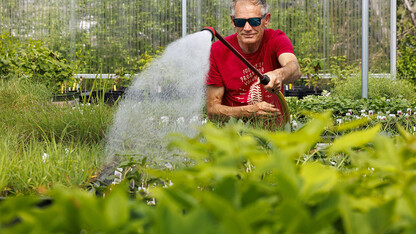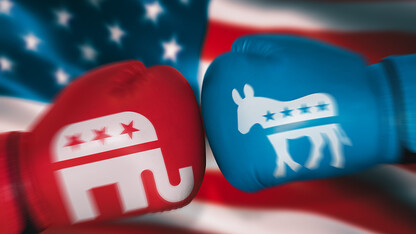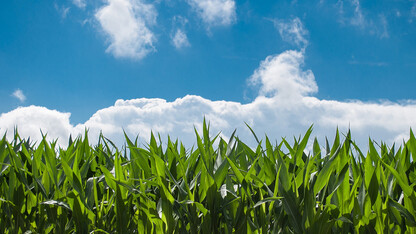· 11 min read
Nebraska nets 550-plus positive media mentions in 2019

A faculty member’s highly anticipated second novel, the largest-ever drone-based investigation of severe storms and a new study showing that politics is making Americans sick drew national media attention for the University of Nebraska–Lincoln in 2019. More than 550 stories featuring the university, its faculty, staff, students, centers and programs appeared in national media outlets during the year.
Chigozie Obioma, assistant professor of English and internationally recognized author, released his sophomore effort, “An Orchestra of Minorities,” on Jan. 8. Described as a modern take on Homer’s “Odyssey,” the book received much positive press. Obioma was interviewed for the New York Times’ By the Book feature on Jan. 3. He also discussed the novel’s origin and themes on NPR’s “Weekend Edition” and in Time magazine, The Guardian, the Houston Chronicle and the Los Angeles Review of Books. Reviews of “An Orchestra of Minorities” appeared in more than 20 major media outlets, and the novel made numerous recommended-reading lists throughout the year. The book also made the shortlist for the prestigious Man Booker Prize in July, garnering more news coverage. Writer Salman Rushdie called the novel one of his favorite reads of 2019.
The Targeted Observation by Radars and UAS of Supercells (TORUS) project — featuring four drones, an NOAA P3 manned aircraft, eight mesonet trucks equipped with meteorological instruments, three mobile radar systems, a mobile LIDAR system and three balloon-borne sensor launchers — ran from May 15 through June 16 across a large sweep of the Great Plains. Adam Houston, associate professor of Earth and atmospheric sciences, coordinated the effort, which involved more than 50 scientists and students from Nebraska, the University of Colorado Boulder, the University of Oklahoma, Texas Tech University and the National Severe Storms Laboratory. The goal of the project is to better understand supercell thunderstorms, which spawn the most-destructive tornadoes, to improve forecasting and ultimately save lives. Stories on the project appeared in five Nebraska media outlets and more than 20 others nationwide, including Gizmodo, Nature, The Washington Post’s Capital Weather Gang blog (1, 2), Weather Underground and WeatherNation.
A new study from the university suggesting that Americans are making themselves sick over politics made headlines in September. The study was authored by Kevin Smith, Olson Chair and professor of political science at Nebraska; John Hibbing, Foundation Regent University Professor of political science at Nebraska; and Matthew Hibbing, associate professor of political science at the University of California, Merced. Nearly 40% of Americans surveyed for the study said politics is stressing them out, one in five reported losing sleep and 4% said they’ve had suicidal thoughts because of politics. The research is the first to comprehensively examine the physical and emotional costs of paying attention to and participating in political discourse. Stories on the research appeared in more than 240 media outlets, including the Boston Globe, CBC Radio’s Quirks and Quarks, Fast Company, NBC News, Newsweek, NPR, the Miami Herald, Today.com and The Wall Street Journal.
Inventors, innovators and trailblazers
Peter Angeletti, associate professor with the Nebraska Center for Virology, and colleagues have found a significant association between the composition of a woman’s cervical microbiome and the presence of pre-cancerous lesions on her cervix. Stories on the research appeared in KMTV, HealthDay, Science Daily, WebMD and a few other media outlets.
James Schnable, associate professor of agronomy and horticulture at Nebraska, and Iowa State University colleagues are developing a wearable sensor that can measure a crop’s sap flow in real time to determine water usage. The researchers hope to better understand and eventually improve how crops respond to drought. Stories on the research appeared in eight Nebraska media outlets, including the Omaha World-Herald, as well as AgFax, Farms.com and Midwest Messenger.
A multi-institution research team led by Erica Ryherd, associate professor of architectural engineering at Nebraska, has found that implementing quiet time in neonatal intensive care units could improve infant health outcomes. The researchers found that during hours when conversations were reduced and lights were dimmed, infants’ heart rates were healthier and stronger. Stories on the research appeared in KETV, the Omaha World-Herald, Daily Mail, HealthDay and a few other media outlets.
Andrea Basche, assistant professor of agronomy and horticulture at Nebraska, and Marcia DeLonge, a senior scientist with the Union of Concerned Scientists, have found that planting perennials and cover crops may substantially improve the ability of soils to soak up heavy rainfall, potentially alleviating the most severe effects of flooding and drought. Stories on the research appeared in five Nebraska media outlets — including the Omaha World-Herald — as well as No-Till Farmer, Phys.org and Western Livestock Journal.
The university has earned an $11.8 million grant from the National Institutes of Health to support the new Rural Drug Addiction Research Center. Kirk Dombrowski, John Bruhn Professor of sociology at Nebraska, will lead the center. Stories on the center appeared in 14 Nebraska media outlets — including KETV, the Lincoln Journal Star and Omaha World-Herald — and several others across the country.
The Johnny Carson Center for Emerging Media Arts opened its doors to students Aug. 26. The program is the first in the Big Ten to earn a Hewlett Packard/Educause Campus of the Future designation. The Carson Center hosted the third annual Inside/Outside Innovation Summit in October and formal dedication activities in November. Stories on the center appeared in eight Nebraska media outlets — including KETV, KLKN and the Omaha World-Herald — as well as the Center for Digital Education. The Carson Center was also highlighted in a March spread in American Way magazine.
The university and Aksarben Foundation announced the Nebraska Tech Collaborative, a new group that aims to bolster the state’s tech workforce, in an Oct. 14 news conference at Nebraska Innovation Campus. Jona Van Deun, president of the collaborative, was introduced during the event. Stories on the collaborative appeared in 11 Nebraska media outlets — including the Lincoln Journal Star, Omaha World-Herald and WOWT — and more than 35 others nationwide. The collaborative was also featured in an Oct. 21 World-Herald editorial and a Dec. 5 Journal Star guest column by Chancellor Ronnie Green.
Karsten Koehler, assistant professor in the Department of Nutrition and Health Sciences; Christopher Gustafson, assistant professor in the Department of Agricultural Economics; and colleagues have found that a person’s choice of post-workout snack can depend on when the choice is made. Study participants who decided before exercising were about one-third more likely to choose a nutritious option than were those who decided afterward. Stories on the study appeared in the Daily Mail and about two dozen other media outlets.
Members of the university’s Theme Park Design Group — a campus club of multiple majors — created enrichment items for the giraffes at the Lincoln Children’s Zoo. The colorful feeders and other playthings were designed and fabricated at Nebraska Innovation Studio. BTN.com published a story on the project April 5.
Trusted experts and recognized authorities
Brad Lubben, extension associate professor of agricultural economics, was interviewed on a wide range of topics in 2019. He discussed concerns over the 2019 corn crop for a May 31 Lincoln Journal Star article that was picked up by two dozen media outlets; the challenges of rural broadband for an Oct. 7 Civil Eats article; and the first phase of a U.S.-China trade agreement for a Dec. 20 High Plains Public Radio story.
Josephine Potuto, Larson Professor of Constitutional Law and former chair of the NCAA infractions committee, continued to be a highly sought-after expert on NCAA matters. Among the topics she discussed this year were the NCAA’s ruling on the suspension of University of Kansas basketball player Silvio De Sousa (Lawrence Journal-World, Feb. 2; Kansas City Star, Feb. 6); the split that occurred about 10 years ago over disparities in wealth and size among Division III institutions (Inside Higher Ed, May 24); and a proposed California law, which later passed, allowing athletes at state colleges and universities to profit from the use of their names, likenesses and images and what it might mean for the NCAA (Associated Press, Aug. 29).
The National Drought Mitigation Center remains a trusted resource for journalists across the country reporting on drought and climate. The U.S. Drought Monitor — a joint effort of the drought center, the U.S. Department of Agriculture and the National Oceanic and Atmospheric Administration — was cited by numerous media outlets throughout the year, including the Associated Press (1, 2), Denver Post, Los Angeles Times (1, 2), NASA, San Francisco Gate (1, 2), Wall Street Journal (1, 2) and Weather Channel. Brian Fuchs, a climatologist with the center, was also interviewed for a June 24 Entrepreneur Fund article on a new study showing that certain tree species can make droughts more intense and an Oct. 3 Associated Press article on the “flash drought” that hit the South.
A sampling of other university experts quoted in 2019:
Craig Allen, School of Natural Resources; Caleb Roberts and Dirac Twidwell, both agronomy and horticulture, July on Phys.org, new study showing shifting Great Plains ecosystems.
Herman Batelaan, physics and astronomy, May on Phys.org, new study pointing to non-Newtonian, quantum force that influences the flight of electrons; October in Popular Mechanics, reaction to experiment demonstrating quantum superposition.
Dawn Braithwaite, communication studies, September in Deseret News, family formation; December in JSTOR Daily, gendering of holiday labor.
Jennine Capó Crucet, English and ethnic studies, September in Vox, race, college, Disney World and her new book of essays, “My Time Among the Whites”; November in Miami New Times, displacement, culture shock and her new book.
Bedross Der Mattossian, history, March in Newsweek, analysis of Turkish President Recep Tayyip Erdogan’s first Armenian tweet.
Christopher Fielding and Tracy Frank, both Earth and atmospheric sciences, January and February in the Daily Mail, Metro, Phys.org and more, new study suggesting that Earth’s largest extinction likely took plants first.
Jody Green, Nebraska Extension, January through May in Reader’s Digest, bed bugs.
David Harwood, Earth and atmospheric sciences, January in Gizmodo, Nature, New Scientist, Scientific American, Smithsonian.com and more, discovery of tiny animal carcasses in subglacial Antarctic lake.
Justin “Gus” Hurwitz, law, October in Los Angeles Times and San Francisco Chronicle, net neutrality; October in The Wall Street Journal, op-ed on how even experts can be misinformed.
Kenneth Kiewra, educational psychology, February in The Conversation and the Associated Press, May in Sporting Kid Live, how parents can develop their children’s talents; September in The Conversation, the Houston Chronicle, Inc. and Quartz, tips for taking better notes.
Kiewra; Amy Struthers, interim dean of journalism; and Matt Waite, journalism; February in The Chronicle of Higher Education’s Teaching newsletter, Nebraska’s pop-up courses.
Kate Lyons, biological sciences, April on Earth.com, how humans have brought about the sixth extinction; September on Before It’s News, Ecology Daily News, Phys.org and more, new study suggesting that the extinction of large mammal species likely drove survivors apart.
Kay Maresh, accountancy, October in NPR, what might be revealed in President Donald Trump’s tax returns.
Rupal Mehta, political science, June in Fair Observer, U.S.-Iran relations, the United States’ withdrawal from the Iran nuclear deal and the Trump administration’s Iran strategy.
Laura Muñoz, history and ethnic studies, July in The Washington Post, why many Latinos in the United States aren’t fluent in Spanish.
Eric North, urban and community forestry, April in SyFy Wire and Omaha World-Herald, charts showing possible growth rates of Groot from “Guardians of the Galaxy.”
Erin Poor, Lied Center for Performing Arts, August in Broadway World, fourth biennial Grow A Show: ASCAP New Musical Theater Workshop at Lied.
Heather Richards-Rissetto, anthropology, March on NBCNews.com, how technology is transforming archaeology.
Paul Royster, University Libraries, May in The Conversation, Houston Chronicle, New Haven Register and more, internet rot.
Philip Schwadel, sociology, March in Pew Research Center’s Fact Tank, how Americans’ drinking habits vary by faith; Schwadel and Aleksandra Sandstrom, June in Fact Tank, how lesbian, gay and bisexual Americans view religious institutions.
Martha Shulski, Nebraska state climatologist; director, Nebraska State Climate Office, July in CBS News’ “A Climate Reckoning in the Heartland,” climate change; December in Politico, increased inquiries regarding climate change.
Frans von der Dunk, space law, February on Inside Higher Ed’s Academic Minute, rights to the moon; March in The Week, space mining; March in Agence France-Presse, India’s destruction of a satellite by missile; May on Good Law/Bad Law podcast, intricacies and challenges of space law; July on “The Craig Silverman Show,” 50th anniversary of the Apollo 11 mission and who owns the moon; July on The Conversation’s To the Moon and Beyond podcast, what a space war might look like and questions about moon mining; July in Vice, colonizing the moon; July in Reuters, issues surrounding the new space race; September in Sputnik News, risk of further militarization of space; September in How Stuff Works, what happens if someone is murdered in space; September in iNews, Asgardia project.
Von der Dunk and Jack Beard, law, January in Agence France-Presse, growing U.S.-China space rivalry.
Christina Yao, educational administration, February in Insider Higher Ed, international students facing cultural insensitivity, discrimination and hostility on college campuses.
University Communication tracks faculty, administration, student and staff appearances in the national media and reports upon them month by month. If you have additions to this list, contact Sean Hagewood, news coordinator, at shagewood2@unl.edu or 402-472-8514. If you have suggestions for national news stories, contact Leslie Reed, public affairs director, at lreed5@unl.edu or 402-472-2059.







